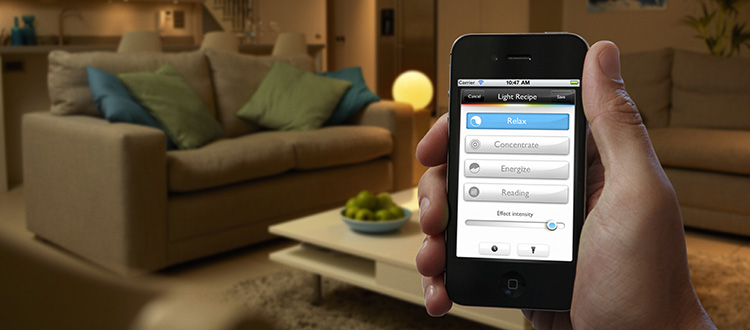
In lighting systems like Philips Hue, the light bulb itself is smart. These bulbs talk to each other via the short-range, low-powered communication standard called ZigBee, allowing wireless control of a lighting system as big or as small as you want — up to 50 lights on one network, in most cases. Photo courtesy Philips Hue
Nov. 15, 2016 | Miles Durie
A bright idea
New bulbs add technology at the flip of a switch The light bulb is a symbol of a bright idea — and the latest generation of bulbs lives up to that symbolism in a big way.
The light bulb is a symbol of a bright idea — and the latest generation of bulbs lives up to that symbolism in a big way.In lighting systems like Philips Hue, GE Link, Belkin's WeMo and several others, the light bulb itself is smart. These bulbs talk to each other via the short-range, low-powered communication standard called ZigBee, allowing wireless control of a lighting system as big or as small as you want — up to 50 lights on one network, in most cases.
The best part is that the bulbs fit into your existing light sockets with no modifications. Just screw them in, flip all your light switches to the "on" position, and power up the proprietary wireless hub that came with your starter kit.
From there, download the free smartphone app for your product and begin saving energy, programming lighting scenes and schedules and — with the Hue product at least — enjoying the literally unlimited range of colour and intensity variations the LED lights offer.
As for those network hubs, they're simple, and connect to your household Wi-Fi.
The ZigBee standard is more or less a line-of-sight connection, but the bulbs work together to form a mesh network. That means bulbs that are out of range from each other can still work in unison as long as there are lights in between to link them up.
There are also smart bulbs on the market that are controlled via Bluetooth. This eliminates the need for a hub, letting a smartphone app stand alone as the control device. Bluetooth has a few limitations, of course: a maximum of eight devices can be networked, and the range maxes out at about 10 metres. But if you want a simple and fun installation for one room, or even just one or two bulbs, a Bluetooth unit like the Flux or Ilumi is worth considering.
ZigBee is capable, at least on paper, of supporting several thousand connected devices. It also boasts much lower latency than Bluetooth — in other words, a ZigBee connection can go from sleep to active mode in less than 30 milliseconds, while a Bluetooth connection can take three seconds to wake up.
So for a practical everyday lighting system for the whole home or a large part of it, I have to recommend ZigBee-connected systems like the Philips, GE and WeMo.
The Philips lights also work with Apple Homekit and Nest setups, offering potential for fully integrated home automation.
What do they cost? The Philips Hue Colour starter kit, which includes the Philips Bridge and three Hue bulbs, retails at about $180. A white-light-only version is around 50 bucks less. Additional bulbs run between $30 and $50, and there's a range of accessories like wall-mounted dimmers, light strips and more available.
The GE Link starter kit, with two white-only bulbs and a hub, is less than $100, as is the Belkin WeMo starter set, also with two white bulbs and the WeMo Link.
All are available locally at home improvement and electronics stores or online.
Miles Durrie's Digital Downlow column appears exclusively in CREB®Now biweekly. Questions? Story suggestions? Email digitaldownlowcalgary@gmail.com.
Tagged: Guest Column




